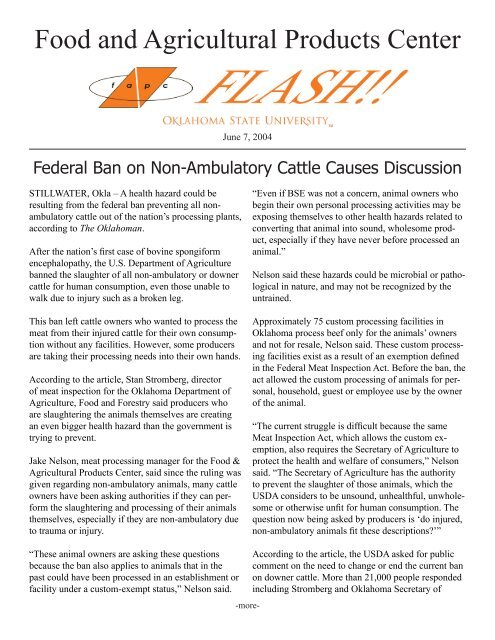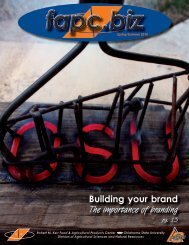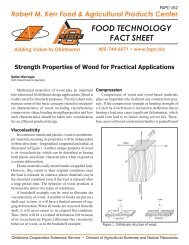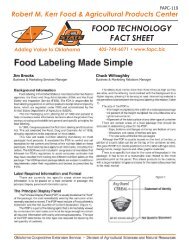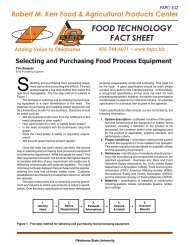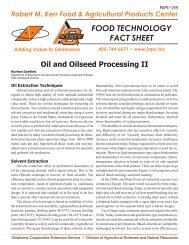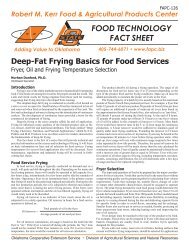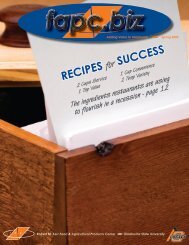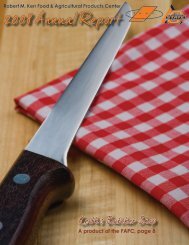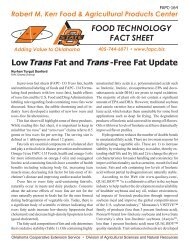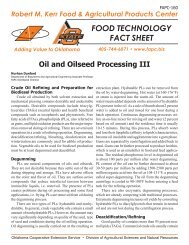Downer Flash - color - Robert M. Kerr Food & Agricultural Products ...
Downer Flash - color - Robert M. Kerr Food & Agricultural Products ...
Downer Flash - color - Robert M. Kerr Food & Agricultural Products ...
Create successful ePaper yourself
Turn your PDF publications into a flip-book with our unique Google optimized e-Paper software.
<strong>Food</strong> and <strong>Agricultural</strong> <strong>Products</strong> Center<br />
June 7, 2004<br />
Federal Ban on Non-Ambulatory Cattle Causes Discussion<br />
STILLWATER, Okla – A health hazard could be<br />
resulting from the federal ban preventing all nonambulatory<br />
cattle out of the nation’s processing plants,<br />
according to The Oklahoman.<br />
After the nation’s first case of bovine spongiform<br />
encephalopathy, the U.S. Department of Agriculture<br />
banned the slaughter of all non-ambulatory or downer<br />
cattle for human consumption, even those unable to<br />
walk due to injury such as a broken leg.<br />
This ban left cattle owners who wanted to process the<br />
meat from their injured cattle for their own consumption<br />
without any facilities. However, some producers<br />
are taking their processing needs into their own hands.<br />
According to the article, Stan Stromberg, director<br />
of meat inspection for the Oklahoma Department of<br />
Agriculture, <strong>Food</strong> and Forestry said producers who<br />
are slaughtering the animals themselves are creating<br />
an even bigger health hazard than the government is<br />
trying to prevent.<br />
Jake Nelson, meat processing manager for the <strong>Food</strong> &<br />
<strong>Agricultural</strong> <strong>Products</strong> Center, said since the ruling was<br />
given regarding non-ambulatory animals, many cattle<br />
owners have been asking authorities if they can perform<br />
the slaughtering and processing of their animals<br />
themselves, especially if they are non-ambulatory due<br />
to trauma or injury.<br />
“These animal owners are asking these questions<br />
because the ban also applies to animals that in the<br />
past could have been processed in an establishment or<br />
facility under a custom-exempt status,” Nelson said.<br />
-more-<br />
“Even if BSE was not a concern, animal owners who<br />
begin their own personal processing activities may be<br />
exposing themselves to other health hazards related to<br />
converting that animal into sound, wholesome product,<br />
especially if they have never before processed an<br />
animal.”<br />
Nelson said these hazards could be microbial or pathological<br />
in nature, and may not be recognized by the<br />
untrained.<br />
Approximately 75 custom processing facilities in<br />
Oklahoma process beef only for the animals’ owners<br />
and not for resale, Nelson said. These custom processing<br />
facilities exist as a result of an exemption defined<br />
in the Federal Meat Inspection Act. Before the ban, the<br />
act allowed the custom processing of animals for personal,<br />
household, guest or employee use by the owner<br />
of the animal.<br />
“The current struggle is difficult because the same<br />
Meat Inspection Act, which allows the custom exemption,<br />
also requires the Secretary of Agriculture to<br />
protect the health and welfare of consumers,” Nelson<br />
said. “The Secretary of Agriculture has the authority<br />
to prevent the slaughter of those animals, which the<br />
USDA considers to be unsound, unhealthful, unwholesome<br />
or otherwise unfit for human consumption. The<br />
question now being asked by producers is ‘do injured,<br />
non-ambulatory animals fit these descriptions?’”<br />
According to the article, the USDA asked for public<br />
comment on the need to change or end the current ban<br />
on downer cattle. More than 21,000 people responded<br />
including Stromberg and Oklahoma Secretary of
Agriculture Terry Peach. Both asked for the USDA to<br />
relax the ban and allow cattle owners to process beef<br />
for their own consumption. Stromberg and Peach have<br />
received support for the ban’s changes from the Oklahoma<br />
Cattlemen’s Association.<br />
A change in the current ban would probably place an<br />
extra burden on the veterinarians who must determine<br />
the health status of animals presented for slaughter,<br />
Nelson said.<br />
“Imagine a possible scenario of an animal with an<br />
injured limb, thus making it non-ambulatory,” he said.<br />
“If the veterinarian did not witness the injury, he or<br />
she may not know if the injury was secondary to, or<br />
caused by another health condition. The veterinarian<br />
would then need to further evaluate that animal to determine<br />
its wholesomeness, fully realizing the scrutiny<br />
that would exist by regulatory officials as well as the<br />
public.”<br />
Though similar comments were received from Wisconsin,<br />
North Dakota, Arizona and West Virginia, the<br />
majority of the comments filed showed support for the<br />
current ban. Some of the commentary stated slaughtering<br />
sick or dying animals for human consumption was<br />
wrong.<br />
According to the article, Scott Dewald, Oklahoma<br />
Cattlemen’s Association’s executive vice president,<br />
said this issue has nothing to do with animal cruelty.<br />
“When we have an animal that is down and hurting,<br />
we want to get that animal taken care of and put out of<br />
its misery as fast as humanly possible,” Dewald said.<br />
Jake Nelson is a meat processing manager at the<br />
<strong>Food</strong> & <strong>Agricultural</strong> <strong>Products</strong> Center. He may be<br />
contacted at (405) 744-6071 or nelsoj@okstate.edu.<br />
Oklahoma State University, in compliance with Title VI and VII of the Civil Rights Act of 1964, Executive Order 11246 as amended, Title IX of the Education Amendments of 1972, Americans with<br />
Disabilities Act of 1990, and other federal laws and regulations, does not discriminate on the basis of race, <strong>color</strong>, national origin, sex, age, religion, disability, or status as a veteran in any of its policies,<br />
practices or procedures. This includes but is not limited to admissions, employment, financial aid, and educational services.<br />
Issued in furtherance of Cooperative Extension work, acts of May 8 and June 30, 1914, in cooperation with the U.S. Department of Agriculture, Sam E. Curl, Director of Oklahoma Cooperative Extension<br />
Service, Oklahoma State University, Stillwater, Oklahoma. This publication is printed and issued by Oklahoma State University as authorized by the Dean of the Division of <strong>Agricultural</strong> Sciences and<br />
Natural Resources and has been prepared and distributed at a cost of $71.40 for 510 copies. 0604 MHG.<br />
###<br />
<strong>Food</strong> and <strong>Agricultural</strong> <strong>Products</strong> Center<br />
Room 148<br />
Stillwater, OK 74078-6055


